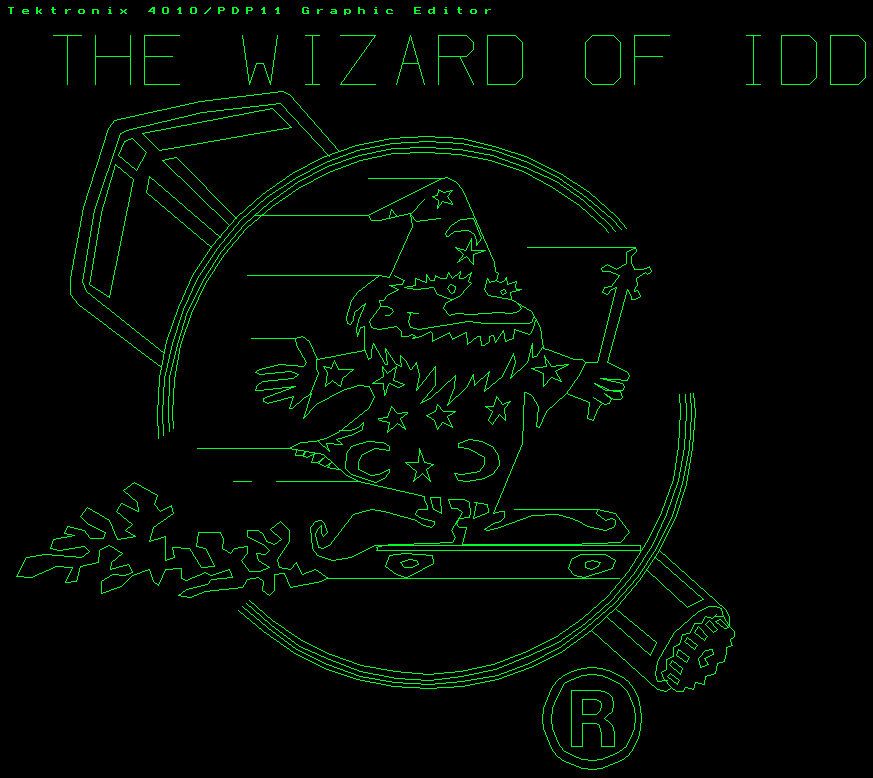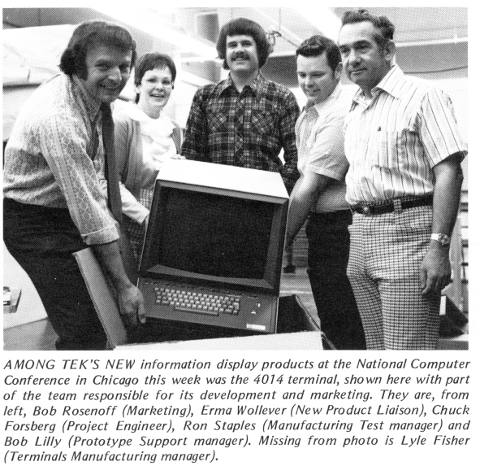THE COMPUTER GRAPHICS MUSEUM
Musée de l'image de synthèse








Sogitec tektronix Maison Vole music revisited CG 1983 from superfunk on Vimeo.
The Tektronix 4014 Workstation was a DVST (Direct View, Storage-Tube) display system. This provided very high resolution (4096 lines) however there was no support for color except of course "light green" and "dark green". Also, due to the way storage tube technology worked, objects that were deleted or blanked were not immediately removed from the screen but rather they were marked with the character "X" and could only be removed by hitting the "Repaint" button which caused the entire display to be erased and then only the visible curves get redrawn. Since this could take some time, particularly on complex drawings, experienced users learned to work with a large number of deleted objects still displayed and would only perform a repaint when the things just got too cluttered to understand, whereas novice users tended to hit repaint after the deletion of each object.
Manufacturer Tektronix
Model 4014
Lifetime
Introduced 1974
Introductory Price $8,450
Discontinued 1985
Communication
Interface RS-232C
Baud Rates 110, 150, 300, 600, 1200, 2400, 4800, 9600
Display
Size 19-inch
Character Modes
Resolutions 74x35, 133x64
Matrix 7x9
Selected Tek Storage Tube Terminals
T4002 611 display with separate one line refreshed editing area.
The original design had alphameric and point plot.
Operation with remote computers via phone lines forced the
addition of a vector generator.









Vectors were drawn with a simple R-C network.
The Writing beam was pulse width modulated for short vectors to prevent
overwriting or CRT burns.
The complicated logic required to support the local editing functions
locked up all too easily.
The TTL logic was spread among a large number of small boards.
These were connected by an expensive 10 or 12 layer backplane.
The T4002 accepted a plug-in ("aux box") in the rear.
One such plug-in provided graphic input with a joystick.
The 96 character 7x9 character generator ROM consisted of discrete diodes
on many small boards. The character generator skipped over dark pixels
to increase speed.
Stan Davis designed a nice analog bell circuit.
4802 Serial interface. Speed controlled by R-C oscillator.
T4002A Various logic cleanups. Character generator used ROMs.




It was the early 70's. Men walked on the Moon. Good looking stewies worked for the airlines. July 1971 brought the Second Annual Conference on Computers in Undergraduate Instruction to Dartmouth University. I was project engineer for the Tektronix 4010 storage tube graphics terminal.
Bob Perterson and I flew out to Dartmouth to introduce the 4010. The Tek travel department booked engineers economy class, but we flew First Class because economy was full. The drinks were free and so were the stewies. We had a great time in United's Friendly Skies. The abrupt transition from high altitude carousing to the O'Hare concourse was a bit of a shock. I was still at 29,000 feet.
We showed some A-phase terminals at the conference. Users suggested product changes, some of which which I incorporated into the 4010.
The 4010 pioneered Tek's use of etched circuit boards in high voltage power supplies. The boards arced over in the hot and humid New England summer. We could barely keep one or two 4010s working with continual emergency care packages from Portland.
Selected Tek Storage Tube Terminals
4010 First model in the 401x series. The logic was in a pedestal.
The 4010 benefited from lessons learned from the T4002 program.
The 4010 was designed for low cost, a fraction of the T4002.
Moderately large logic boards plugged into a simple backplane.
The 4010 "Minibus" had minimal addressing (CSTROBE/TSTROBE)
and time domain arbitration with the CPUNT signal.
The base model 4010 had TC1, TC2, and an interface board.
The character generator used a commercial 5x7 64 character ROM.
The character generator used unlit pixels above the characters
to allow the deflection to stabilize its slew and wrote dots on the fly.
Character writing speed was about half that of the T4002A.
Graphic input was standard with a pair of crossed thumbwheels..
Constant 2.6 ms vectors were drawn with 2nd order R-C active filter.
There was no compensation for short vectors.
The logic was greatly simplified and could not be locked up.
A 4.9152 MHz crystal provided timing for serial interfaces,
character generation, vector drawing, graphic input, even the bell.
I was project engineer and there was NO BLOODY FAN.
4010-1 A -1 indicated hard copy readout circuitry
4012 A better yoke supported 7x9 upper and lower case characters.
A prototype analog fast vector board shortened the time constant
for short vectors and the end of long vectors.
4013 4012 with ASCII/APL keyboard and character generator

4014 19 inch storage tube using a TV glass envelope.
Four character sizes available up to 133 x 64 lines.
4096x3072 12 bit addressing, write-thru and defocus modes.
Hardware dotted/dashed digital vectors designed by Dick Preiss.
Large linear power supply but NO FAN. Still civilized.
4015 4014 with ASCII/APL
4016 25 inch storage tube with noisy fan. Logic same as 4014
4006 Stripped down 4010. The bare essentials of the 4010.
No backspace. No pedestal. No graphic input. LSI chip used for serial I/O.
The logic was based on a sketch I made years previously of a single board
4010 subset to advocate reducing the difference in selling price between
the 4010 terminal and 613 monitor.
4081 Workstation powered by an Interdata 7/16 minicomputer.
We wanted to use our own CPU but weren't allowed to.
Upper management insisted this was to be some sort of Uberterminal.
We wanted to build a workstation. The only successful app was
as a workstation (so I'm told).
Basic serial interface provided speeds from 150 to 9600 bits per second.
It was implemented in discrete logic because the available serial
converter chips were so buggy a large amount of TTL was needed to fix the bugs.
Buffered serial interface - 64 deep FIFO on receive, could be modified
to drop ClearToSend when terminal busy
Audio Recorder Interface - Recorded and played sessions at up to 9600 bps.
Used for demoing terminals when a computer was unavailable. Could also
be used for primitive file backup.
I developed a PDP-11 parallel interface for the 4010 series at Tektronix.
This emulated the standard DEC TTY serial interface. Its use with Unix was
problematic due to the high per character interrupt processing overhead.
This overhead was insignificant at 110 bps, but brought Unix to a near
standstill driving the 4014 in graphics. The solution was to write a
small program using the Unix phys(2) call to access the hardware directly.
I kludged a parallel interface for Linux using the Centronics parallel
port. See phys.c for details.
TTY Port interface - Dick Preiss designed a higher speed interface that
provided the serial clock signal to the host. The clock could be stopped
when the 401x was busy to prevent overruns.